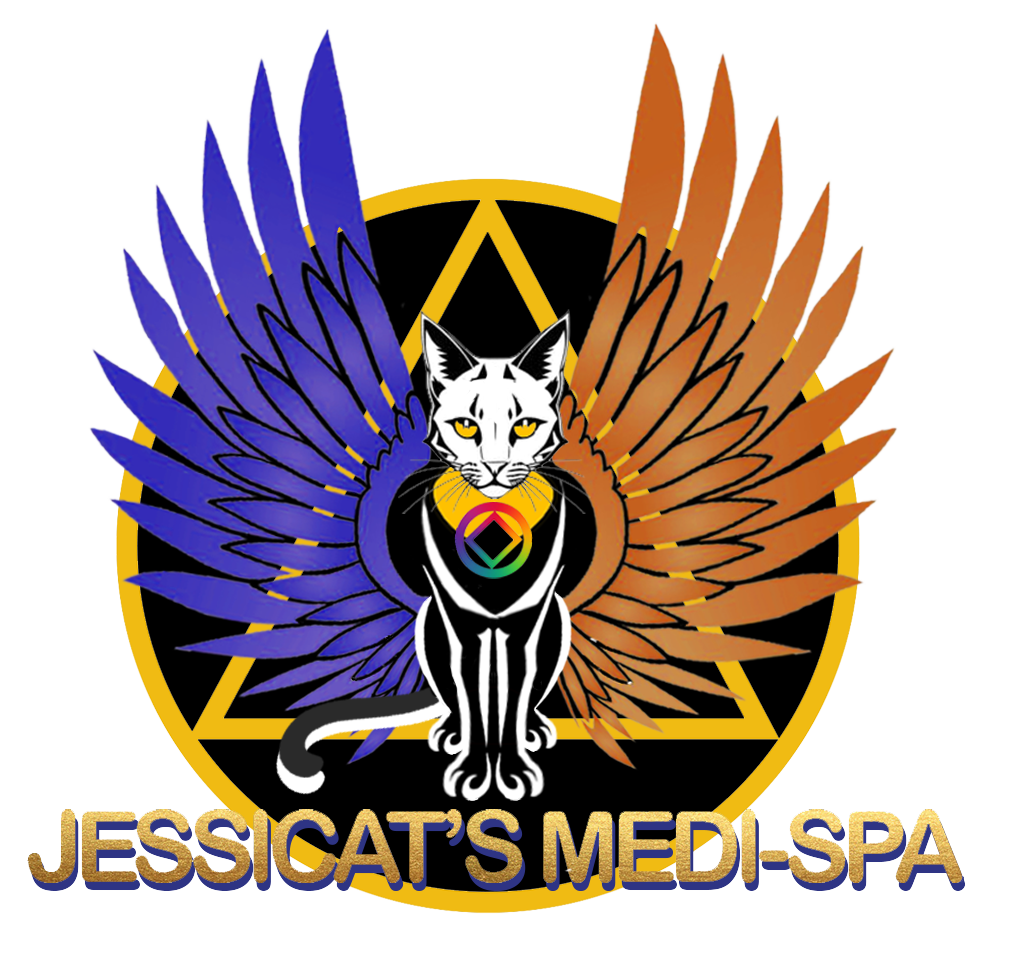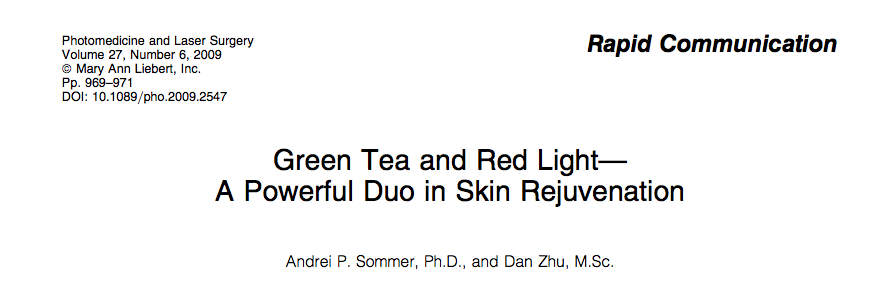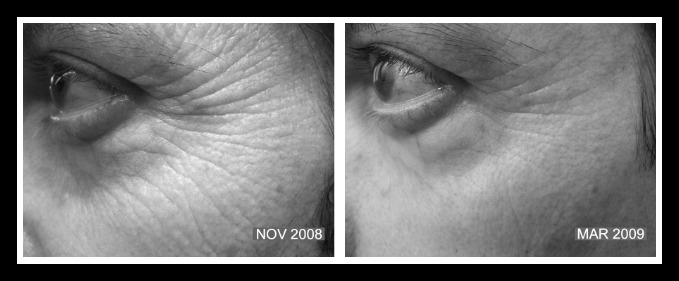Abstract
Andrei P. Sommer, Ph.D., and Dan Zhu, M.Sc.
Objective: Juvenile skin has been the subject of intense research efforts since ancient times. This article reports on synergistic complementarities in the biological actions of green tea and red light, which inspired the design of a green tea–assisted facial rejuvenation program. Background Data: The approach is based on previous laboratory experiments providing insight into a mechanism by which visible light interacts with cells and their microen- vironment. Methods: After 2 months of extreme oxidative stress, green tea–filled cotton pads were placed once per day for 20 minutes onto the skin before treatment with an array of light-emitting diodes (central wavelength 670nm, dermal dose 4J=cm2). Results: Rejuvenated skin, reduced wrinkle levels, and juvenile complexion, previously realised in 10 months of light treatment alone were realised in 1 month. Conclusion: The accelerated skin rejuvenation based on the interplay of the physicochemical and biological effects of light with the reactive oxygen species scavenging capacity of green tea extends the action spectrum of phototherapy. The duo opens the gate to a multitude of possible biomedical light applications and cosmetic formulas, including reversal of topical deterioration related to excess reactive oxygen species, such as greying of hair.
Introduction
Earlier we reported on the results of our first facial rejuvenation program, which was based on the physicochemical and biological effect of visible light: restoration of the functionality of elastin fibres by progressive reestablish- meant of the native surface polarity of the elastin simultaneous activation of the cellular metabolism. The expectation for a change in surface polarity was substantiated by laboratory experiments showing that 670 nm light, applied at moderate intensities commonly used in phototherapy, al- altered the molecular structure of interfacial water layers on model surfaces.
Between November 2007 and September 2008, one of us irradiated the skin around the corner of the eyes with light delivered by arrays of light-emitting diodes (WARP 10, Quantum Devices, Inc., Barneveld, WI). Operating in the range of 600 to 720 nm (central wavelength 670 nm) the light field covers an area of 10cm2 with an integral intensity of 72.8 mW=cm2. Irradiation doses were 4 J=cm2—the golden standard in phototherapy.1 The representative photographs of the facial zones (Figure 4 in 2) show the change in wrinkle levels for 9 consecutive weeks of daily treatment. The change for 10 months is displayed on the cover of the journal.2 The principal discovery described in our previous work is that
facial wrinkle levels could be significantly reduced by ex- tended irradiation of the skin with the red light.
Materials and Methods
In the second facial rejuvenation program, starting in December 2008, the same person continued to irradiate the skin around the corner of the eyes using the previously es- established protocol. The principal difference from phase I of the rejuvenation program in megacities in China (1 month) and Africa, including Cairo (1 month), directly before phase II of the light treatment. This exposed the skin of the test person to massive environmental stresses including high levels of ultraviolet radiation and heat stress from the interplay of high levels of infrared radiation with extreme particulate matter concentrations in the air, expected to influence the thermoregulatory capacity of the facial skin (5% of the total body skin surface). Figure 1 (left) shows the condition of the facial skin in Africa, 1 day before the end of the journey. Apparently, 2 months of strong sun and air pollution was sufficient to completely undo the 10 months of light treatment. This was the starting point of phase II, which continued for 2 months according to the aforementioned protocol until February 2009, virtually without change in wrinkle levels. At this point, we modified the routine and introduced topical application of green tea. The motivation emerged from insight into remarkable complementarities between the biological actions of green tea and red light.
Results
The representative photographs in Figure 1 show facial wrinkle levels after 2 months of exposure to extreme oxidative
stress (left) and wrinkle levels after 1 month of daily application of green tea for 20 min and a dermal dose of 4 J=cm2 of red light (right).
FIG. 1. Photographs show the skin before phase II of the rejuvenation program and after 1 month of green tea–assisted red light application. Less-pronounced wrinkle levels with shorter wrinkle valleys and juvenile complexion after including green tea in the program.
The targets of the light used in phototherapy are the cells and the extracellular matrix (ECM). In the ECM, it can undo cumulative physiological degradations, as illustrated in our model study.2 In the cells visible to near-infrared light is absorbed by photosensitizers, for instance, cytochrome c oxidase,3 and generates intensity and dose dependently reactive oxygen species (ROS).4 Whereas small amounts of ROS have been found to stimulate cell activity5—probably a key element in the mechanism of photobiomodulation—lar- ger amounts can inhibit cellular processes.6 However, higher light doses, exceeding the associated upper limit set by the classical Arndt-Schultz concept, can be necessary, for in- stance, when targeting deeper tissue layers or addressing the ECM.2 Thus, control of ROS levels can be crucial to prevent oxidative damage to cell components. A powerful natural ROS scavenger is green tea, known for its extraordinary antioxidative and photoprotective capacities, in some cases, clinically exploited simply by drinking it.7 Its major and most protective polyphenolic component is epigallocatechin gal- late (EGCG).8 Modalities of administration, oral and topical are both effective, as confirmed in animals8 and humans.9 The action spectrum of green tea includes the ECM, where EGCG can undo ROS-related degradations,10 and cells, where EGCG can increase cell survival rate (keratinocytes) 11—a surprising parallel to the effects of red light. In sum, the combination of green tea and red light appears to be a most effective rejuvenating duo. To test it, we filled cotton pads with green tea (concentration, 3g dry leaf mass per 250 mL of water; brewing temperature, 1008C; cooling time, 30 min) and placed them for 20 min onto the skin around the corner of the eyes before irradiating the wrinkled zones directly according to the protocol. Recent work indicates that the extracting efficiency of EGCG from green tea is dependent on solvents, temperature, and duration, with highest recovery yields at 908C for 60 min brewing in 35% ethanol.12.
Discussion
The skin, in particular, that of the face, is a major target of environmental stress such as provoked by air pollution and ultraviolet and infrared radiation, potentially contributing to an increase in ROS levels, which can cause significant damage to cell structures: the oxidative stress. Remarkably, by liberating moderate or excessive ROS levels, the light employed in phototherapy has the potential to stimulate or inhibit cellular processes, respectively. Green tea has the capacity to compensate for environment-induced oxidative stress13 and, as recommended by the results of our study, to act as a powerful ROS scavenging agent that could accelerate the therapeutic effect of light. From considering the complementary action of visible light and green tea with regard to ROS, this is not surprising. Presumably, the complementarity is not limited to compensational effects. As recently reported, EGCG at 1mg=mL extended the lifespan of Caenorhabditis elegans—the standard tool in anti-aging research—under heat and oxidative stresses by 8.0% and 177.7%, respectively.14 The longevity- extending effects in the worm were absent in the absence of stresses—a remarkable analogy to the biostimulatory effect of visible light, which is virtually absent in balanced systems. Possibly, topically applied green tea extends the survival of the cells involved in transporting ECM metabolites from the basal layer to the stratum corneum. Indeed, the model, which in- spired the design of our first facial rejuvenation program, indicated the instrumentality of the applied light in a coordinated process: liberation of ECM metabolites and simultaneous stimulation of cells to incorporate them. The interplay of the three processes offers one explanation for the juvenile complexion accompanying the reduced wrinkle levels. Could temporally and dose-optimized combinations of green tea and red light have further biomedical potentials? Further investigation into this issue is underway.
Conclusion
In an exceptional case of oxidative stress, we demonstrated that the combination of green tea and red light can accelerate the rejuvenating effect of the light. The accelerated skin rejuvenation based on the coordinated interplay of the physicochemical and biological effects of the light with the ROS scavenging capacity of green tea extends the current action spectrum of phototherapy. This could open the gate to a multitude of biomedical and cosmetic applications of the combination green tea and red light, for instance, novel irradiation techniques considering the transepidermal penetration of EGCG and compatible skin rejuvenation formulas. Potential applications include but are not limited to the reversal of topical deterioration related to anomalous levels of reactive oxygen species, such as greying of hair.15
References
- Mester, E., Mester, A.F., and Mester, A. (1985). The bio- medical effects of laser application. Lasers Surg. Med. 5, 31– 39.
- Sommer, A.P., and Zhu, D. (2008). From microtornadoes to facial rejuvenation: implication of interfacial water layers. Cryst. Growth Des. 8, 3889–3892.
- Wong-Riley, M.T., Liang, H.L., Eells, J.T., et al. (2005). Photobiomodulation directly benefits primary neurones functionally inactivated by toxins: role of cytochrome c oxidase. J. Biol. Chem. 280, 4761–4771.
- Xu, X., Zhao, X., Liu, T. C-Y., and Pan, H. (2008). Low- intensity laser irradiation improves the mitochondrial dysfunction of C2C12 induced by electrical stimulation. Photomed. Laser Surg. 26, 197–202.
- Gao, X., and Xing, D. (2009). Molecular mechanisms of cell proliferation induced by low power laser irradiation. J. Biomed. Sci. 16, 4.
- Lubart, R., Landau, Z., Lipovsky, A., and Nitzan, Y. (2008). A new light device for wound healing. Rec. Pat. Biomed. Eng. 1, 13–17.
- Hunstein, W. (2007). Epigallocathechin-3-gallate in AL am- yloidosis: a new therapeutic option? Blood 110, 2216.
8. Katiyar, S., Elmets, C.A., and Katiyar, S.K. (2007). Green tea and skin cancer: photoimmunology, angiogenesis and DNA repair. J. Nutr. Biochem. 18, 287–296.
9. Katiyar, S.K. (2003). Skin photoprotection by green tea: antioxidant and immunomodulatory effects. Curr. Drug. Tar- gets Immune. Endocr. Metabol. Disord. 3, 234–242.
10. Lee, J.H., Chung, J.H., and Cho, K.H. (2005).The effects of epigallocatechin-3-gallate on extracellular matrix metabolism. J. Dermatol. Sci. 40, 195–204.
11. Chung, J.H., Han, J.H., Hwang, E.J., et al. (2003). Dual mechanisms of green tea extract (EGCG)-induced cell survival in human epidermal keratinocytes. FASEB J. 17, 1913–1915.
12. Hu, J., Zhou, D., and Chen Y. (2009). Preparation and anti- oxidant activity of green tea extract enriched in epigallocatechin (EGC) and epigallocatechin gallate (EGCG). J. Agric. Food Chem. 57, 1349-53.
13. Bae, J.Y., Choi, J.S., Choi, Y.J., et al. (2008). (-)Epigallocatechin gallate hampers collagen destruction and collagenase activation in ultraviolet-B-irradiated human dermal fibro- blasts: involvement of mitogen-activated protein kinase. Food Chem. Toxicol. 46, 1298–1307.
14. Zhang, L., Jie, G., Zhang, J., and Zhao, B. (2009). Significant longevity-extending effects of EGCG on Caenorhabditis elegans under stress. Free Radic. Biol. Med. 46, 414–421.
15. Wood, J.M., Decker, H., Hartmann, H., et al. (2009). Senile hair greying: H2O2-mediated oxidative stress affects human hair colour by blunting methionine sulfoxide repair. FASEB J. 23, 2065–2075.
Address correspondence to:
Andrei P. Sommer, Ph.D. Institute of Micro and Nanomaterials University of Ulm Albert-Einstein-Allee 47 89081 Ulm Germany
E-mail: andrei.sommer@uni-ulm.de


